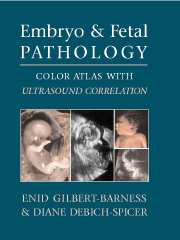Book contents
- Frontmatter
- Contents
- Foreword by John M. Opitz
- Preface
- Acknowledgments
- 1 The Human Embryo and Embryonic Growth Disorganization
- 2 Late Fetal Death, Stillbirth, and Neonatal Death
- 3 Fetal Autopsy
- 4 Ultrasound of Embryo and Fetus: General Principles
- 5 Abnormalities of Placenta
- 6 Chromosomal Abnormalities in the Embryo and Fetus
- 7 Terminology of Errors of Morphogenesis
- 8 Malformation Syndromes
- 9 Dysplasias
- 10 Disruptions and Amnion Rupture Sequence
- 11 Intrauterine Growth Retardation
- 12 Fetal Hydrops and Cystic Hygroma
- 13 Central Nervous System Defects
- 14 Craniofacial Defects
- 15 Skeletal Abnormalities
- 16 Cardiovascular System Defects
- 17 Respiratory System
- 18 Gastrointestinal Tract and Liver
- 19 Genito-Urinary System
- 20 Congenital Tumors
- 21 Fetal and Neonatal Skin Disorders
- 22 Intrauterine Infection
- 23 Multiple Gestations and Conjoined Twins
- 24 Metabolic Diseases
- Appendices
- Index
24 - Metabolic Diseases
Published online by Cambridge University Press: 23 February 2010
- Frontmatter
- Contents
- Foreword by John M. Opitz
- Preface
- Acknowledgments
- 1 The Human Embryo and Embryonic Growth Disorganization
- 2 Late Fetal Death, Stillbirth, and Neonatal Death
- 3 Fetal Autopsy
- 4 Ultrasound of Embryo and Fetus: General Principles
- 5 Abnormalities of Placenta
- 6 Chromosomal Abnormalities in the Embryo and Fetus
- 7 Terminology of Errors of Morphogenesis
- 8 Malformation Syndromes
- 9 Dysplasias
- 10 Disruptions and Amnion Rupture Sequence
- 11 Intrauterine Growth Retardation
- 12 Fetal Hydrops and Cystic Hygroma
- 13 Central Nervous System Defects
- 14 Craniofacial Defects
- 15 Skeletal Abnormalities
- 16 Cardiovascular System Defects
- 17 Respiratory System
- 18 Gastrointestinal Tract and Liver
- 19 Genito-Urinary System
- 20 Congenital Tumors
- 21 Fetal and Neonatal Skin Disorders
- 22 Intrauterine Infection
- 23 Multiple Gestations and Conjoined Twins
- 24 Metabolic Diseases
- Appendices
- Index
Summary
Most metabolic disorders due to inborn errors of metabolism are inherited as autosomal recessive traits; some are X-linked. A few are dominant traits. Mitochondrial enzymes are coded by both the maternal nuclear genome and by the mitochondrial DNA. Some disorders can be detected by newborn screening (Table 24.1). Placental changes (Table 24.2) may be present and suggest a lysosomal storage disease. Skin fibroblasts, conjunctiva, intestinal biopsy, peripheral nerve, muscle, bone marrow and amniocytes may be used in the diagnoses of metabolic disease (Table 24.3). Vacuolated lymphocytes (Table 24.4) also may be seen in a number of storage diseases.
AMINO ACID DISORDERS
A number of disorders of amino acid metabolism have been described including phenylketonuria, tyrosinemia, alkaptonuria, homocystinuria, lysinemia, and cystinosis (Figures 24.1 and 24.2 and Tables 24.5 and 24.6). These disorders are rarely observed in the fetus or newborn infant.
MUCOPOLYSACCHARIDOSES
These disorders are distinguished by storage of glycosaminoglycans (GAG) (mucopolysaccharides) and glycolipids in the lysosomes of different cell types, including fibroblasts, macrophages, white blood cells, parenchymal cells of liver, kidneys, brain and other organs, and neurons, and by excretion of mucopolysaccharide in the urine (Table 24.7).
When the tissue is fixed in GAG-insoluble fixatives such as alcohol, the accumulated material shows intense metachromasia (purple-blue staining) with toluidine blue and stains with Alcian blue, weakly with periodic acid-Schiff (PAS), and is impregnated with colloidal iron. Lipid may be abundant.
Hurler disease is characterized by coarse features, prominent supraorbital ridges, depressed nasal bridge and dysostosis multiplex (Figures 24.3 to 24.5). Beaking of the vertebral bodies may be apparent in the fetus and newborn.
- Type
- Chapter
- Information
- Embryo and Fetal PathologyColor Atlas with Ultrasound Correlation, pp. 635 - 656Publisher: Cambridge University PressPrint publication year: 2004



